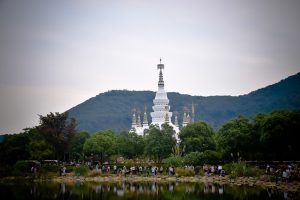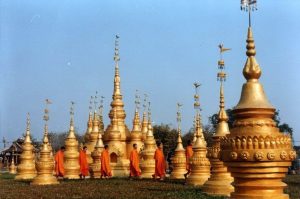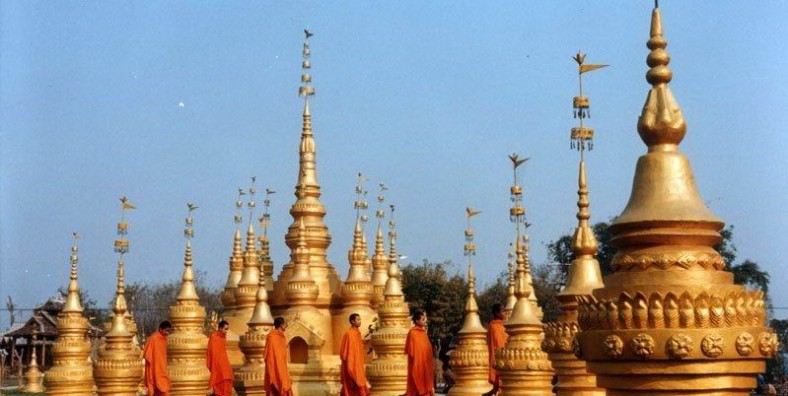
Damenglong Scenic Area in Jinghong City, Xishuangbanna
XishuangBanna Damenglong Scenic Area in Jinghong City travel guide introduces the main attractions, entrance tickets booking, The best time to visit, How to Get there, the highlights, facts, history, photos, weather, accommodation, visiting routes, travel tips, tour maps of Damenglong Scenic Area in XishuangBanna(大勐龙景区).
● Chinese Name: 大勐龙景区
● Keywords: Pogada, Hinayana Buddhism, Dai Culture
● Location: Damenglong Town, Jinghong City, Xishuangbanna,Yunnan, China
● Scenic Area: 117.2 square kilometers
● Admission Fee: 5rmb
● Opening Hours: 8:30 am-6:00 pm
‣ About Damenglong Scenic Area
The sleepy town of Damenglong is located about 60km south of Jinghong, the capital of the Xishuangbanna autonomous region, and bordering Myanmar. Via the recently finished new road, Damenglong can now be reached within an hour from Jinghong. The scenic area is famous for Hinayana Buddhism architecture, especially lots of pagoda, so it get reputation of “Hometown of Pagoda”. The main spots are Manfeilong Pagoda, White & Black Pagoda, Triones Pagoda, Xiaojie Hot Spring, Manfeilong Reservoir.
The main attraction of Damenglong is the “Manfeilong” or “White Bamboo Shoot” Pagoda reportedly dating back to the early 13th century. The Manfeilong Pagoda is located approximately 3km north of Damenglong on a hill and is almost entirely surrounded by rubber tree plantations. There is another Pagoda right above the town which offers nice views of the Damenglong at the surroundings.

Manfeilong Pagoda
The Manfeilong Pagoda is situated on the top of a hill near Manfeilong Village, 70 kilometers (43 miles) away from Jinghong City. It was built in the year 1024 and is a famed stupa complex in Xishuangbanna. It is also known by two other names: White Pagoda and Bamboo Shoot Pagoda. These descriptive names are derived from the fact that the pagoda is, of course, white while its overall shape resembles a bamboo shoot. It is dedicated to Hinayana Buddhism (a small, conservative branch of Buddhism).
The Manfeilong Pagoda consists of nine stupas. Seen from the distance, they look very like bamboo shoots that have emerged from the soil after the spring rain. They are made of bricks, with typical club-like bases topped by calabash shaped bodies. The principle and central stupa, which is 16.29 meters (53 feet) high, is surrounded by eight smaller stupas, each being 9.1 meters (30 feet) high. In each stupa, there is a niche wherein a statue of Buddha is laid. The bells hung at the top of the pagoda make a tinkling sound when the wind blows. Just to the south of the pagoda, there is a footprint on the rock. According to legend, this is the left footprint of Sakyamuni, the founder of Buddhism.

The Manfeilong Pagoda is decorated with beautiful sculpture, relief and colored paintings in the style of the Dai ethnic minority. During the Water-splashing Festival (usually on April 13-15), the villagers from the Manfeilong Village gather here and chase one another, splashing water as part of a welcome to the new year in Dai calendar.
‣ Attraction Transportation
Go around: Take bus from Jinghong Bus Station which leave every 10 minutes, 15rmb for one bus ticket,
‣ Best Time to Visit
Belonging to tropical rainforest climate, Xishuangbanna’s dry season is from November to April the next year and rainy season is from May to October. With annual average temperature of 21c, it has long summer and no winter. With cool and pleasant four seasons, the best time for traveling Xishuangbanna is from October to June the next year.
‣ Tips
All the information is for reference only, if there was any change, please follows the information of scenic area.

 7 Days GolfingTour
7 Days GolfingTour
 8 Days Group Tour
8 Days Group Tour
 8 Days Yunnan Tour
8 Days Yunnan Tour
 7 Days Shangri La Hiking
7 Days Shangri La Hiking
 11 Days Yunnan Tour
11 Days Yunnan Tour
 6 Days Yuanyang Terraces
6 Days Yuanyang Terraces
 11 Days Yunnan Tour
11 Days Yunnan Tour
 8 Days South Yunnan
8 Days South Yunnan
 7 Days Tea Tour
7 Days Tea Tour
 8 Days Muslim Tour
8 Days Muslim Tour
 12 Days Self-Driving
12 Days Self-Driving
 4 Days Haba Climbing
4 Days Haba Climbing
 Tiger Leaping Gorge
Tiger Leaping Gorge
 Stone Forest
Stone Forest
 Yunnan-Tibet
Yunnan-Tibet
 Hani Rice Terraces
Hani Rice Terraces
 Kunming
Kunming
 Lijiang
Lijiang
 Shangri-la
Shangri-la
 Dali
Dali
 XishuangBanna
XishuangBanna
 Honghe
Honghe
 Kunming
Kunming
 Lijiang
Lijiang
 Shangri-la
Shangri-la
 Yuanyang Rice Terraces
Yuanyang Rice Terraces
 Nujiang
Nujiang
 XishuangBanna
XishuangBanna
 Spring City Golf
Spring City Golf
 Snow Mountain Golf
Snow Mountain Golf
 Stone Mountain Golf
Stone Mountain Golf

















